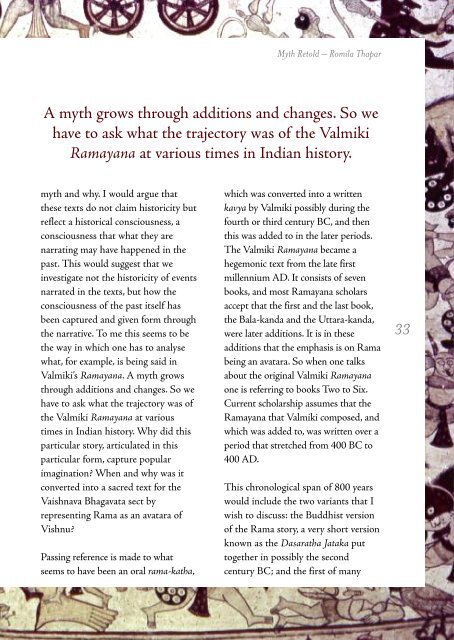Layout 3 - India Foundation for the Arts - IFA
Layout 3 - India Foundation for the Arts - IFA
Layout 3 - India Foundation for the Arts - IFA
You also want an ePaper? Increase the reach of your titles
YUMPU automatically turns print PDFs into web optimized ePapers that Google loves.
Myth Retold – Romila Thapar<br />
A myth grows through additions and changes. So we<br />
have to ask what <strong>the</strong> trajectory was of <strong>the</strong> Valmiki<br />
Ramayana at various times in <strong>India</strong>n history.<br />
myth and why. I would argue that<br />
<strong>the</strong>se texts do not claim historicity but<br />
reflect a historical consciousness, a<br />
consciousness that what <strong>the</strong>y are<br />
narrating may have happened in <strong>the</strong><br />
past. This would suggest that we<br />
investigate not <strong>the</strong> historicity of events<br />
narrated in <strong>the</strong> texts, but how <strong>the</strong><br />
consciousness of <strong>the</strong> past itself has<br />
been captured and given <strong>for</strong>m through<br />
<strong>the</strong> narrative. To me this seems to be<br />
<strong>the</strong> way in which one has to analyse<br />
what, <strong>for</strong> example, is being said in<br />
Valmiki’s Ramayana. A myth grows<br />
through additions and changes. So we<br />
have to ask what <strong>the</strong> trajectory was of<br />
<strong>the</strong> Valmiki Ramayana at various<br />
times in <strong>India</strong>n history. Why did this<br />
particular story, articulated in this<br />
particular <strong>for</strong>m, capture popular<br />
imagination? When and why was it<br />
converted into a sacred text <strong>for</strong> <strong>the</strong><br />
Vaishnava Bhagavata sect by<br />
representing Rama as an avatara of<br />
Vishnu?<br />
Passing reference is made to what<br />
seems to have been an oral rama-katha,<br />
which was converted into a written<br />
kavya by Valmiki possibly during <strong>the</strong><br />
fourth or third century BC, and <strong>the</strong>n<br />
this was added to in <strong>the</strong> later periods.<br />
The Valmiki Ramayana became a<br />
hegemonic text from <strong>the</strong> late first<br />
millennium AD. It consists of seven<br />
books, and most Ramayana scholars<br />
accept that <strong>the</strong> first and <strong>the</strong> last book,<br />
<strong>the</strong> Bala-kanda and <strong>the</strong> Uttara-kanda,<br />
were later additions. It is in <strong>the</strong>se<br />
additions that <strong>the</strong> emphasis is on Rama<br />
being an avatara. So when one talks<br />
about <strong>the</strong> original Valmiki Ramayana<br />
one is referring to books Two to Six.<br />
Current scholarship assumes that <strong>the</strong><br />
Ramayana that Valmiki composed, and<br />
which was added to, was written over a<br />
period that stretched from 400 BC to<br />
400 AD.<br />
This chronological span of 800 years<br />
would include <strong>the</strong> two variants that I<br />
wish to discuss: <strong>the</strong> Buddhist version<br />
of <strong>the</strong> Rama story, a very short version<br />
known as <strong>the</strong> Dasaratha Jataka put<br />
toge<strong>the</strong>r in possibly <strong>the</strong> second<br />
century BC; and <strong>the</strong> first of many<br />
33


